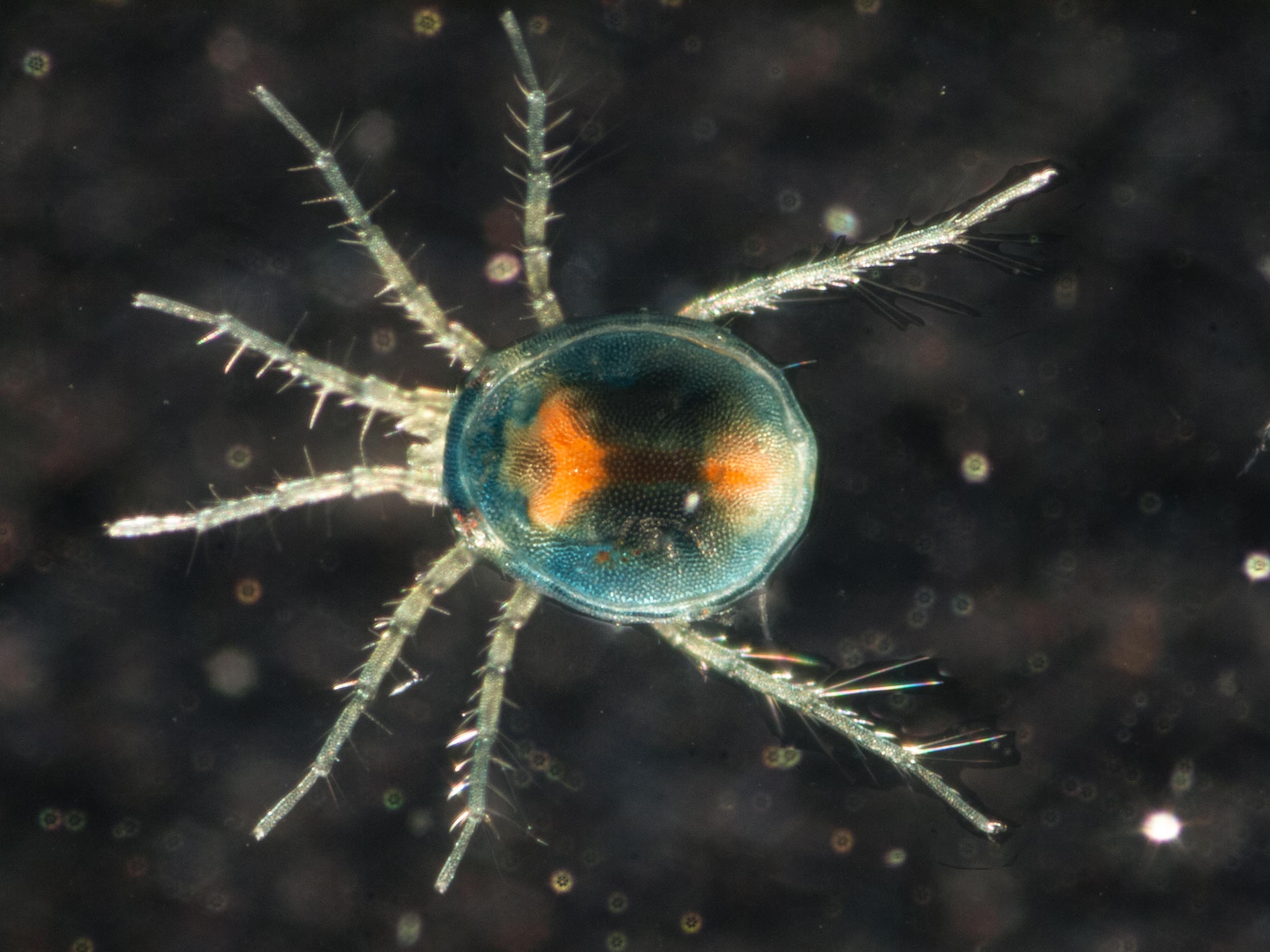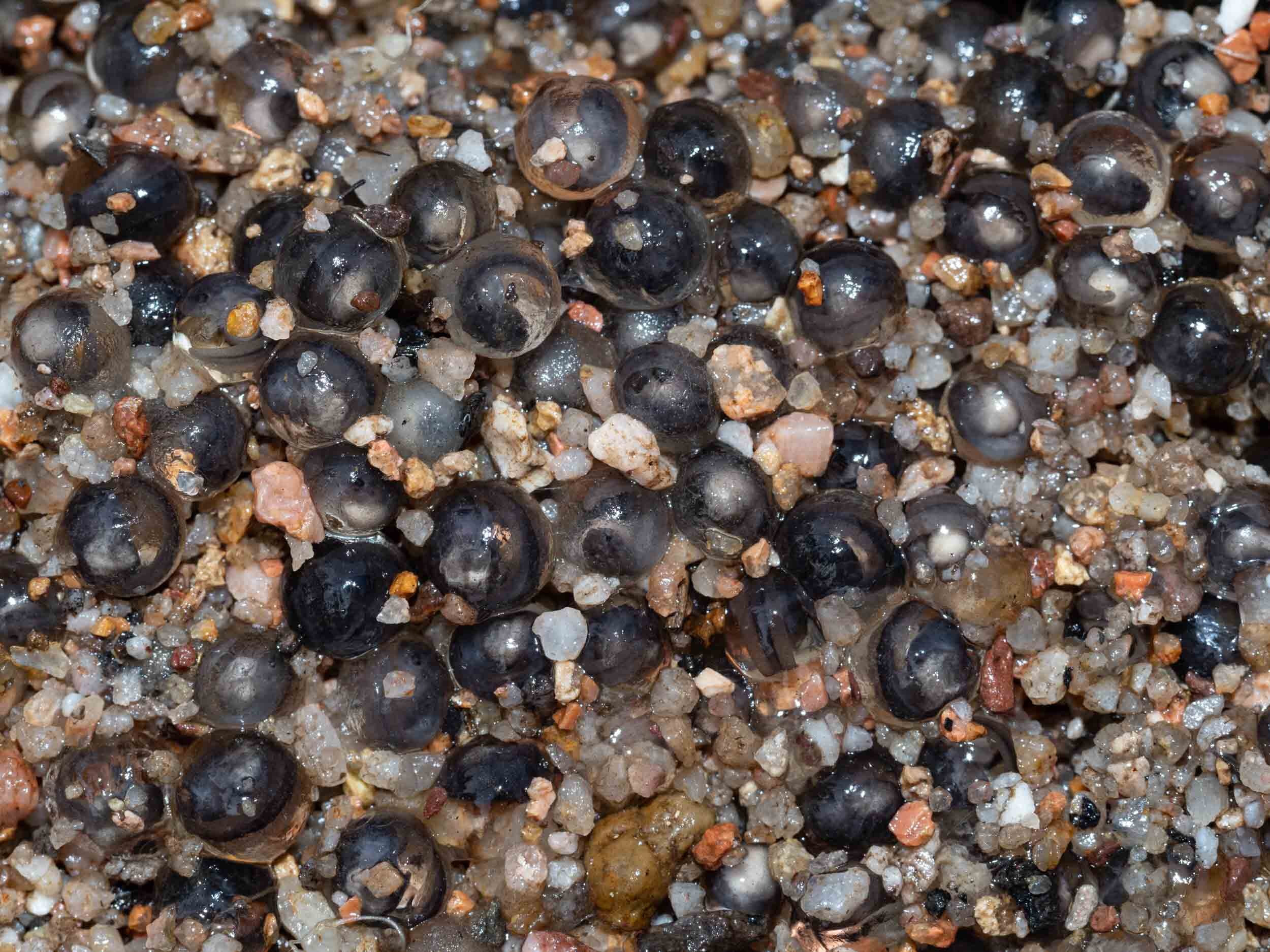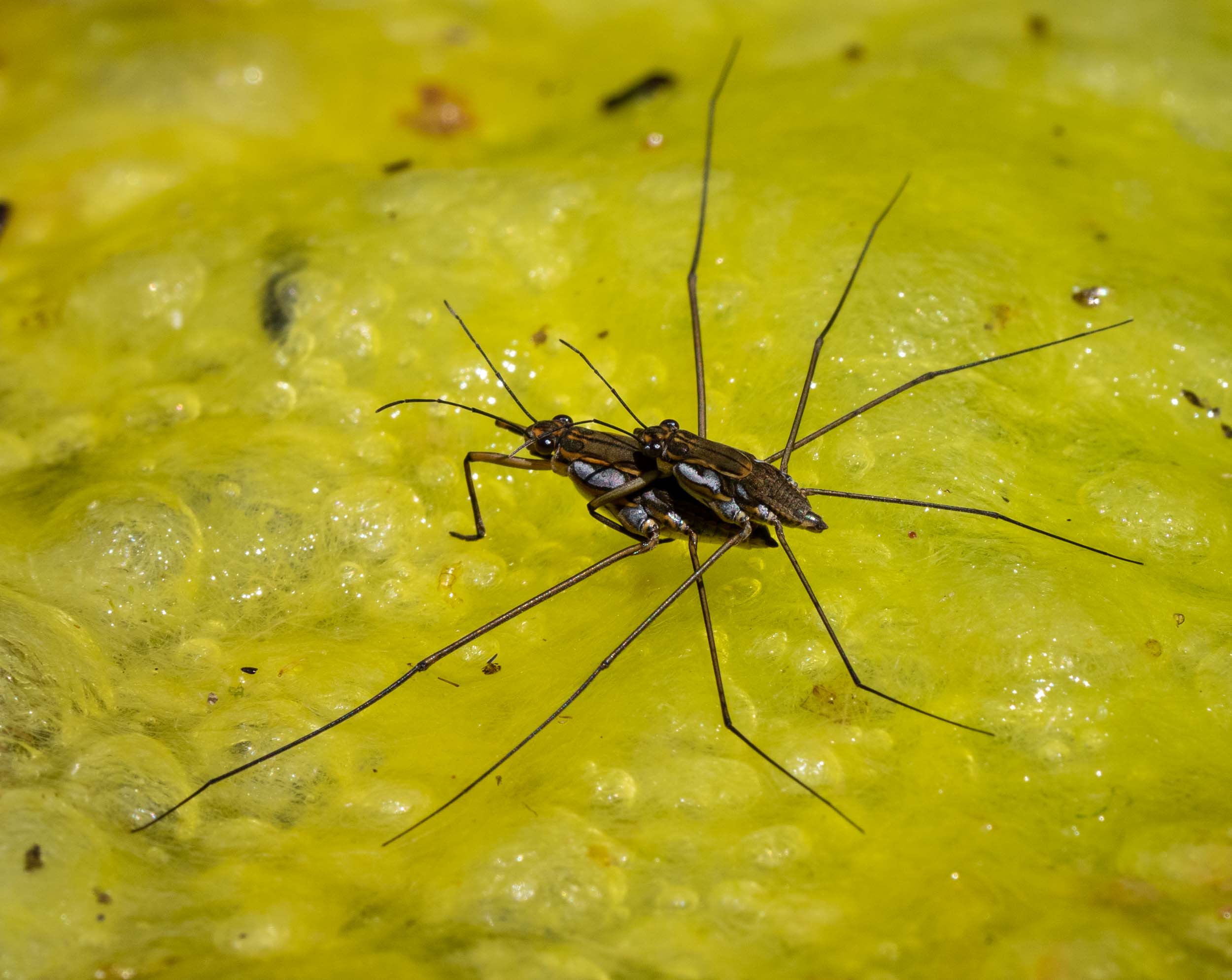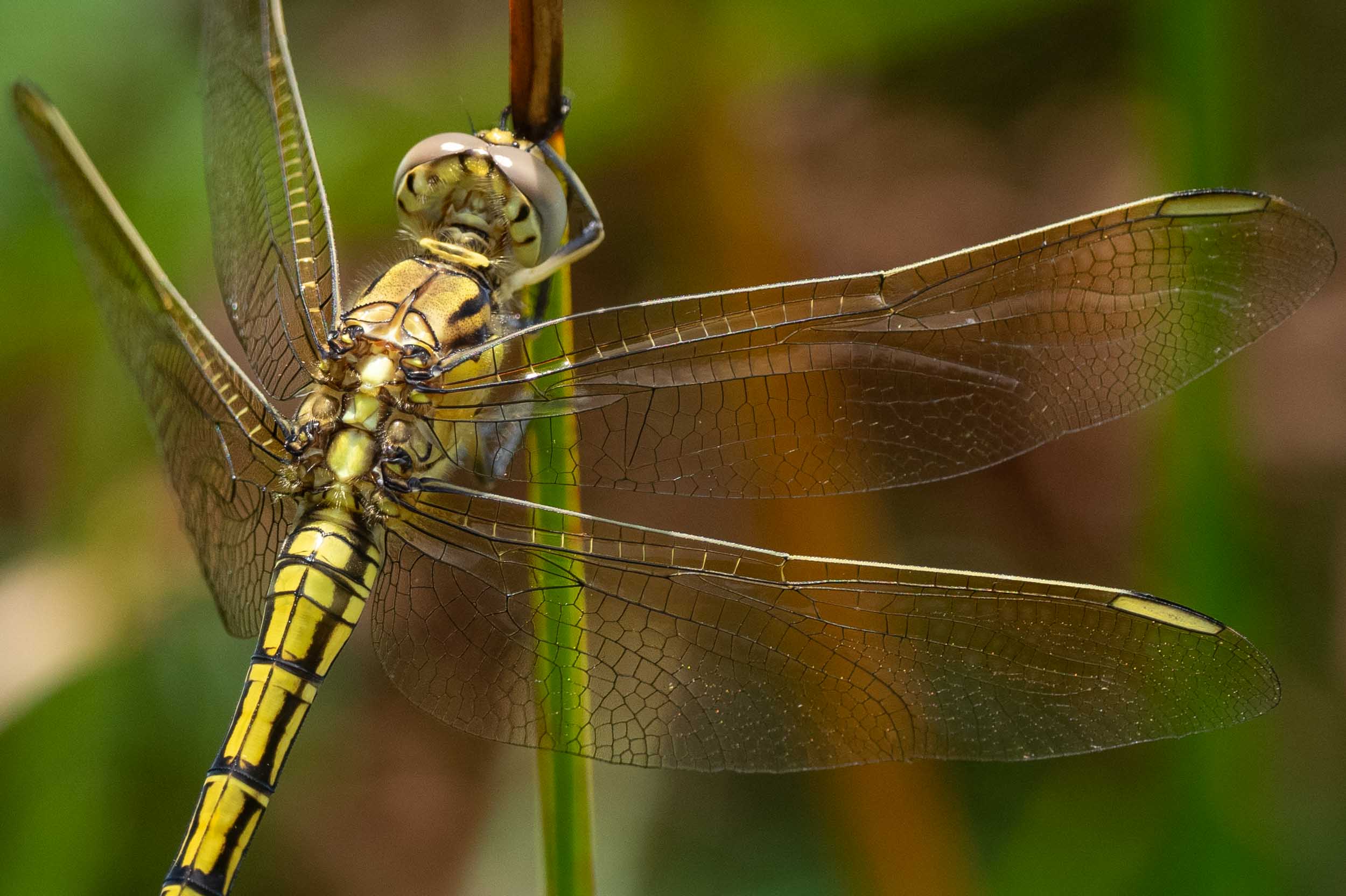The wonders of pond life

Spring is fast approaching. The signs are everywhere. Each day there are more birds in the forest, calling for all they’re worth. The beard heath is flowering in earnest. Native bees and even skinks are reappearing.
Despite these early signs of change, there are still very few flying insects. They are out there, but most are remaining hidden for now.
Although these beetle larvae are interesting, we decided to take a peek into a rather different insect hiding place - freshwater streams and pools. So I dipped a net into the creek just a short distance upstream, and also into our little frog pond here at home.
We last did this in early Autumn. At that time the diversity of ‘large’ animals was quite extraordinary (see Autumn Short Stories blog).
This week, a rather different story. Most of the insects are very very small. There are huge numbers of caddisflies plus many tiny mayflies and stoneflies, but few dragonflies or damselflies.
So I’ve been thinking – and reading – a bit more about the biology and life histories of these various animals.
Caddisflies (Insecta; Trichoptera)
A caddisfly spends most of its life as a larva, underwater. After hatching from an egg attached to submerged rocks or plants, the caddis larva feeds and grows through a series of moults. It takes many months. Some species are vegetarian, scraping algae and microorganisms from leaves and rocks. Others are active hunters, preying on other small aquatic animals. In Summer the larva will pupate and then emerge as a flying adult that looks rather like a small moth. Its adult life will be brief. Small wonder they are rarely noticed.
There are around 500 species of caddisfly in Australia, making Trichoptera more biologically diverse than our butterfly fauna.
Hunter caddis are, as the name suggests, predators. The front legs are specially modified, with pincers or – as in the one below – sharp claws.
All caddis larvae produce silk and they use it in various ways. Case-living caddis use it to construct their portable homes, and even free-living caddis like the one above will drag a silk line for safety.
The net spinning caddis fashion a silken basket to catch food in flowing streams. They are omnivores, eating whatever animals or vegetation is snared in the net. And they usually live in a retreat, alongside their net. I guess when I sampled the creek I damaged this one’s home. It was crawling slowly about the sorting tray, no net in sight.
Caddis larvae are most recognisable as ‘walking sticks’. Many species build themselves portable cases from twigs, sand, leaves or other materials in the environment.
Case-living caddis are usually herbivores or omnivores. There are many families that construct a case, and sometimes the case is a very good clue to the identity of the insect. The various examples below are not identified, although many will belong to the ‘stick caddis’ family, Leptoceridae. The gallery illustrates the diverse homes of case-living caddis.
Most of these larva will never grow wings. They will become food long before they have the chance. Everything likes to eat caddis larvae – frogs, fish, dragonfly larvae and various other underwater carnivores.
However, as we were sorting through our collection of pond life we noticed an insect struggling on the water surface. It was clearly an emerging adult. And a closer look has me convinced it’s a caddisfly. The hairy wings, the very long antennae, and the straight mouthparts are a clue.
step 1 – the pharate adult seeking to crawl out of the water. It has completed the pupal stage but the adult is still contained within the cuticle it had as a larva.
step 2 - the pupal case splits along the back and the adult drags itself free
step 3 - a rather soggy looking adult emerges. It would probably have had an easier time of it back at the creek. In fact I didn’t hold out much hope that it would survive, but later in the day it had disappeared! No doubt flying about the house somewhere for a day.
Mayflies (Insecta; Ephemeroptera)
The second most common insect we found were the mayflies. They are easily recognised by their thin triple ‘tails’ and abdominal gills. Of course, sometimes bits are missing. Lost legs, gills or tails reappear after the next moult – a common trick among arthropods.
Mayfly larvae are well studied and they are an excellent indicator of water quality. Some families are highly sensitive to water pollution while others are far more tolerant. The particular species mix collected in a sample can be used as one indicator of the health of an aquatic ecosystem.
There are around 100 species of mayfly in Australia, in seven families. One of the largest families is the Leptophlebiidae - and indeed all the larvae we collected were ‘leptophelbs’. The family, overall, is quite sensitive to water quality. It has a SIGNAL score of 8.
species 1 – Atalophlebia species are reported to be very common in slow moving waters. We discovered just a few in the sample from the creek. Interestingly, this is one genus which is quite tolerant of less pristine environments.
species 2 - the vast majority of the mayflies looked identical. All were small, and some were tiny. They were distinctly flattened, as are all leptophlebs, with broad legs and square heads. When disturbed they would swim with rapid, vertical undulations of the entire body … a stroke known as the ‘dolphin swim’.
Like the caddisflies, mayflies spend most of their lives as larvae. Most feed on algae or detritus, although there are a few carnivorous species too.
Mayflies are rather famous for their extremely short adult lives. Adults don’t feed and rarely live more than a day.
Stoneflies (Insecta; Plecoptera)
There are 200 species of stoneflies in Australia, and nearly all are found nowhere else.
All the stonefly larvae we collected were small and looked more-or-less identical. They belong to the large family Gripopterygidae. Common name? Fluffy-bums! They have a tuft of gills at the tip of the abdomen and it is common to see them ‘tail-wagging’.
From egg to adult can take years. Some eggs will have delayed development and the larvae themselves can live for many months or years. This varies with different species. Most larvae are detritivores, but there are a few carnivorous species too.
I’ve never seen an adult stonefly. We reliably find larvae so we surely we can track down the adults! Stoneflies are specialists of temperate climates – such as ours – and are not found in the tropics. That is, they’re locals, so we really need to get to know them better.
The adults live for up to four weeks so this Summer I’ll be stalking them, creekside. They are apparently poor fliers, resting and feeding on algae and lichen covered rocks and logs close to water.
Dragonflies (Insecta; Odonata; Anisoptera)
We found only one dragonfly larva! And, yes, we did search for them. We sampled the creek ‘riffle’, where the water bubbles over the rocky shallows. I dragged my net through vegetation along a shady edge of the pool. And we stirred up the mud and leaf litter in a shallow backwater.
Interestingly, the one we found was large. The rate at which dragonflies grow is determined by food availability and water temperature. This one was either an excellent hunter or she is quite old.
She (or he) belongs to the Telephlebiidae family, which includes some of the largest invertebrate predators in streams! The adults are also large insects and strong fliers, commonly called ‘darners’. We have several candidate species in this region, including the Forest Darner (Austroaeschna pulchra). Again, I’ve never seen an adult Telephlebiidae. Again, it’s on my to-do list for the Summer.
Like most other large, aquatic invertebrates, dragonfly larvae have gills. However, they’re hidden away in the most unlikely place! The large rectal chamber is lined by rows of tracheal gills, and the animal ventilates them by pumping water in and out. It can use this same action to make a fast getaway when needed, propelling itself with a rapid expulsion of water from its rear end. Field guides rather cheekily refer to this as a ‘bum jet’.
Damselflies (Insecta; Odonata; Zygoptera)
Again, damselfly larvae were not common in our waterbug sample. We found just two, and of a single species.
Odonata larvae are all carnivores. They hunt by stealth. However, when they sense potential prey their response is lightning fast. The key is in the highly modified mouthparts. The labellum (or lower lip) is huge, hinged, and equipped with claws or teeth at the end. The speed of extension is due to both direct muscle action, and the indirect effect of filling with body fluid as the animal contracts its strong thoracic muscles.
The two damselflies we found were rather special. They are Bronze Needles - Synlestes weyersii (family Synlestidae). We see the adults on occasion, and only ever in the vegetation overhanging fast-flowing streams. The family rates a SIGNAL score of 7, indicating their sensitivity to polluted water. And they really are beautiful insects … see my Dragonfly Habitats blog from last December.
There were three other ‘stand out’ sightings for me. They are not insects. One is not even an arthropod. Some are beautiful, one is weird, and together they highlight the sheer diversity of life histories among freshwater invertebrates.
Copepods (Crustacea; Copepoda)
Free-living copepods are found in all kinds of still or slow-moving bodies of water. They are small, rarely more than a couple of millimetres long. Most feed on phytoplankton, filtering vast amounts of water in order to extract the microscopic algae.
A copepod starts life as a tiny nauplius larva, using its head appendages for swimming. It grows and moults several times before reaching the adult stage. And then, unlike insects, it can continue to grow and moult. The whole life cycle may be completed in anything from a week to a year! Most animals live for 6-12 months.
Females carry their developing eggs with them until the larvae hatch. Indeed the eggs sacs are one of the most recognisable features of copepods.
Many copepods can survive unfavourable conditions by forming a cyst and remaining dormant.
To appreciate the complexity of these tiny animals you really need a microscope. Paul took these wonderful shots using a special rig we have, a Tessovar. It’s effectively a super-macro lens on a stable stand, to which you can attach a camera. But even with this wonderful tool, photographing copepods isn’t easy. They are highly active animals, rarely stopping long in any one place. Paul’s patience paid off!
Species 1
We found several of this species in our small frog pond. The long antennules and the single egg sac identify it as belonging to the Calanoida group. These are planktonic species, using their long hair-covered antennules to aid in buoyancy. The other appendages (‘legs’) are used to propel the animal. The single eye is typical of all copepods. The red structure at the posterior end may be the seminal receptacle - where the female holds the sperm until she is ready to fertilise and ‘lay’ her eggs. In this species, the fertilised eggs are retained in a sac that functions as a brood chamber.
Species 2
We collected several of these tiny animals from the creek. The paired egg sacs and shorter antennules distinguish it from Species 1 and identify it as belonging to the Cyclopoida group.
Water mites (Arachnida; Acarina; Hydrachnidia)
These colourful, eight-legged animals are predators for most of their lives. They pierce their prey with the first pair of mouthparts, inject digestive fluids, and then suck up their meal. And their favourite meal? Tiny crustacea, such as copepods!
Their entire life history is, however, a little more complex.
Eggs are laid on submerged vegetation. The newly-hatched nymph has just 6 legs, and it’s a parasite. The host? Very often an aquatic insect larva!
Again, these animals are tiny. And again, I enlisted Paul’s help to image them. I think these little arachnids win the prize for the most beautiful of all the aquatic animals we found this week.
I’m not about to hazard a guess as to their identification, but Species A and Species B are clearly quite different.
Gordian Worm (Nematomorpha)
Less beautiful than the copepods and mites, this worm wins the prize for the most bizarre life cycle.
Adult Gordian Worm … 20cm long!
This one is an adult and he, or she, is searching for a mate. It won’t feed, yet it may live for months. Once it does mate it will soon die. If it’s a female, she’ll first lay thousands of eggs – and then die.
It’s only the larvae that ever leave the pond. Here’s the story …
A newly-hatched larva will encyst on vegetation at the water’s edge.
If it’s lucky, it will be swallowed by a grazing grasshopper or cricket.
It then leaves the cyst, burrows through the insect’s gut, and takes up residence in the body cavity. Here it feeds by absorbing nutrients directly through its own body wall.
It feeds and grows until it fills the insects body.
Then, when the thirsty and dying insect visits water, the worm breaks out as a free-living adult. Any water will do. Gordian worms are even found in horse troughs!
While I’m reasonably confident of the identifications assigned above, there is no guarantee that I have every one correct.
Here is a list of excellent resources, all of which I’ve been trawling for many hours this week:
ALT Keys v1.5. 2017. The Waterbug Company Pty Ltd. The ALT keys and the excellent Waterbug App are available online from the National Waterbug Blitz site – at no charge! The annual Waterbug Blitz is now underway for the 2019 season. Take a look, and plan a survey of your own dam or creek sometime soon.
Barnes, R.D. 1980. Invertebrate Zoology (4th ed). Holt-Saunders International Editions.
Gooderham, J. & Tsyrlin, E. 2002. The Waterbug Book – a guide to the freshwater macro invertebrates of temperate Australia. CSIRO Publishing, Clayton.
Williams, W.D. 1980. Australian Freshwater Life – the invertebrates of Australian inland waters. The Macmillan Company of Australia.


































































